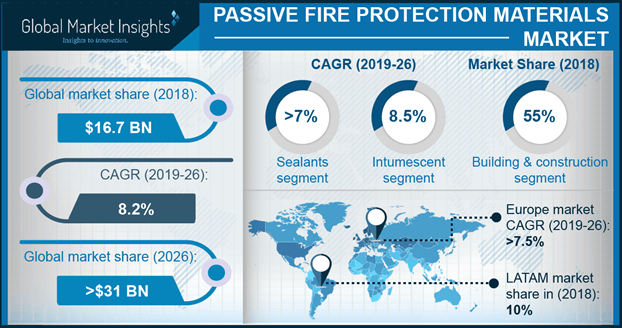Passive Fire Protection Materials Market trends
Passive Fire Protection Materials Market to witness a CAGR of 8.7% over 2017-2024, product innovations and R&D activities to outline the competitive landscape
In a major turn of events encompassing the passive fire protection materials marketplace, the strategic collaboration between AkzoNobel and Benarx Solutions is certainly a news that is grabbing most of the attention lately. Somewhat toward the last quarter of 2017, AkzoNobel, a formidable player in passive fire protection materials industry, has reportedly, inked a marketing and distribution agreement with Benarx Solutions AS, the majority owned subsidiary of Beerenberg Group, in a bid to enhance its product portfolio in the business space. Allegedly, the agreement grants AkzoNobel the authority to combine its wet-applied fire protection solutions with Benarx’s innovative dry based Passive fire protection materials products specially dedicated for oil and gas sector. Experts have been already raving about the collaboration, claiming it to bring a disruptive trend in the entire passive fire protection materials market with a diversified platter of innovative solutions for various complex projects.
U.S. passive fire protection materials market size, by end-user, 2013 – 2024 (USD Bn)

In recent times, safety measures in commercial and residential infrastructure has a bigger role to play than anticipated, a factor that has tremendously upscaled passive fire protection materials industry demand. Based upon the data received from the National Fire Experience Survey of 2016, public fire departments in the United States were reported with over 1.3 million fire accidents in 2016, resulting in a casualty of almost 3,390 civilians, allegedly the highest in number since 2008. The astoundingly mammoth prevalence is prompting passive fire protection materials market players to come up with efficient and effective fire protection coatings for residential and commercial infrastructures as well. Moreover, stringent governmental legislations with regard to domestic fire safety are further complementing passive fire protection materials industry growth.
Get a Sample Copy of this Report:@ https://www.gminsights.com/request-sample/detail/2305
Persistently being channelized by the continuous improvisation of building standardization, the competitive landscape of passive fire protection materials industry is strongly characterized by product innovations via R&D activities. In this regard, recently, passive fire protection materials market has witnessed the inception of an absolutely innovative fire-resistant coating named Firoshield. Collaboratively being launched by researchers of Nanyang Technological University and engineers from JTC Corporation, the latest coating is claimed to cost half than that of conventional coatings. Add to it, sources claim that these coatings can be applied to structural materials in half the time than that of its traditional counterparts. Allegedly, this state of the art version of fire protective coating would be sent to U.K for industry certification purposes, which is reported to be completed by April, this year.
Some of the other leading names contending a strong portfolio in passive fire protection materials market include Rudolf Hensel, Teknos, Promat International, 3M, Lloyd Insulations, Hempel, and Sherwin-Williams. Most of these giants are bending over backwards on R&D investments to spurt their product portfolio in the strategic landscape. To cite an instance of the same, recently, Jotun, the Norwegian chemical giant has declared its plan of establishing a completely new R&D center at Flixborough, United Kingdom. Reportedly, the project led with an initial investment of GBP 4.5 million would exclusively focus on fire insulation and protection coatings, in a bid to reinforce Jotun’s position at the vanguard of the burgeoning passive fire protection materials industry. Considering the aforementioned initiations, it is quite coherent to mention that the passive fire protection materials market is overt to witness a plethora of opportunities over the ensuing years. Obviously, the market’s fullest potential can only be achieved through joint contribution from both private as well as government entities. However, with the globe treading on the path of sustainability trends along with profound research activities addressing the same, it is undeniable that passive fire protection materials market would also record a tremendous stature in terms of product innovations and revenue. In terms of commercialization, worldwide passive fire protection materials industry size is claimed to exceed a valuation of USD 27 billion by 2024.
Author Name : Satarupa De
